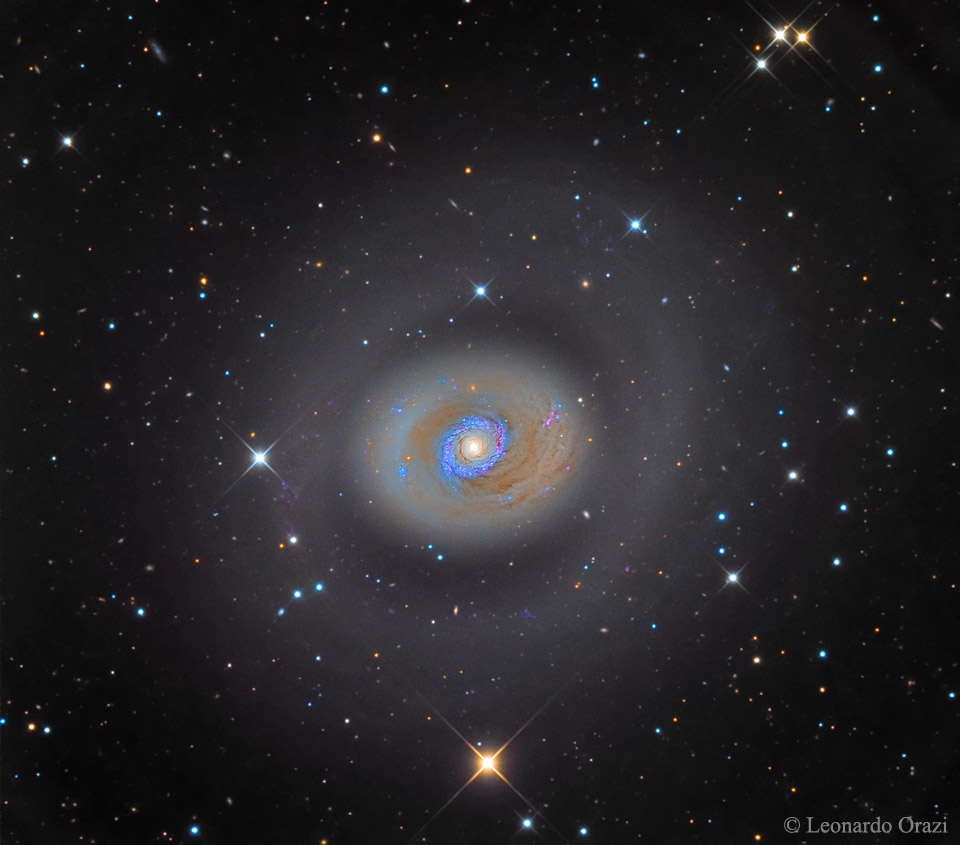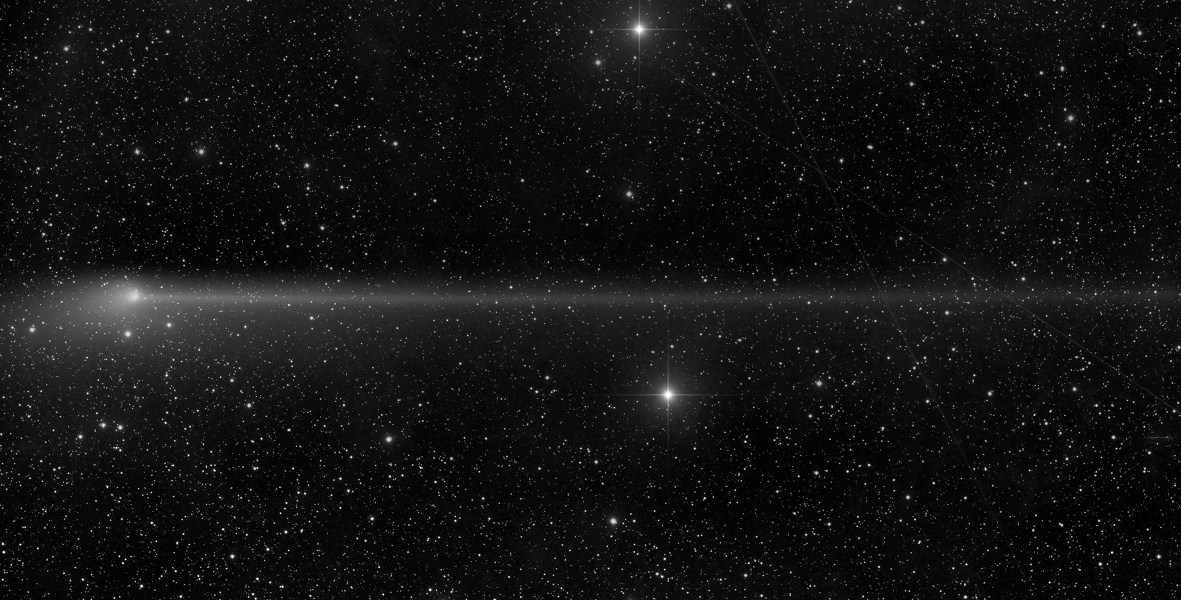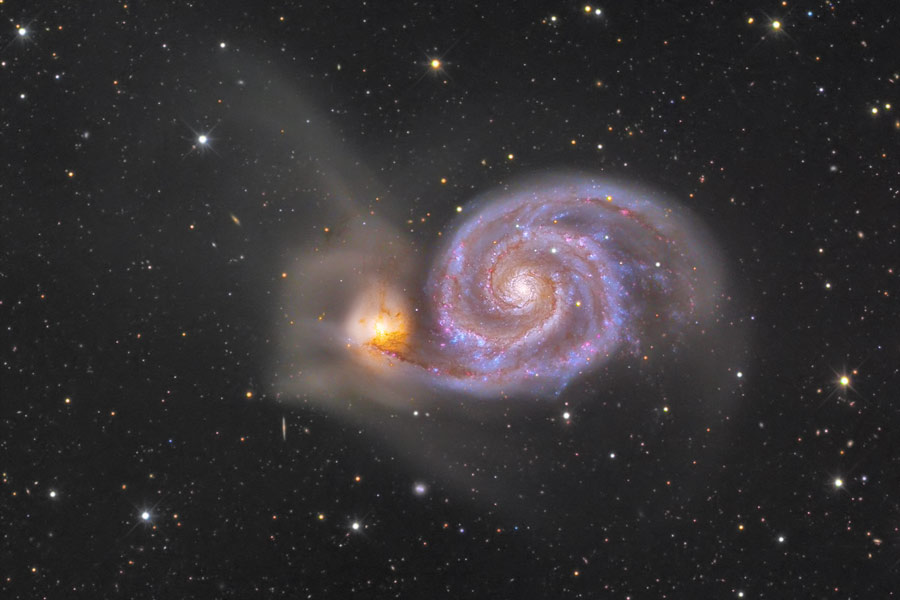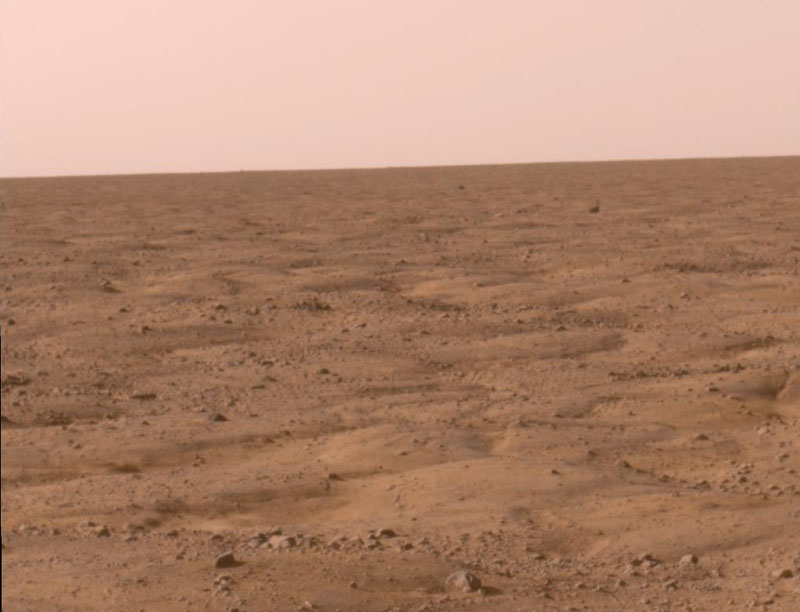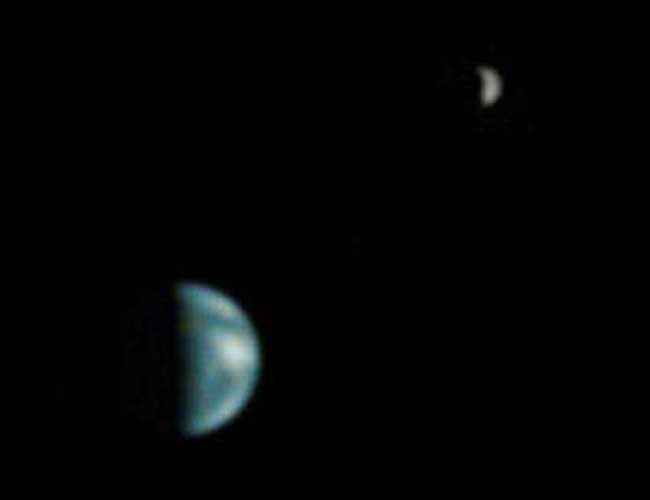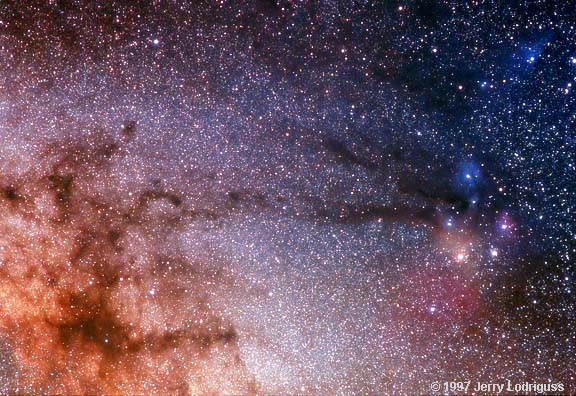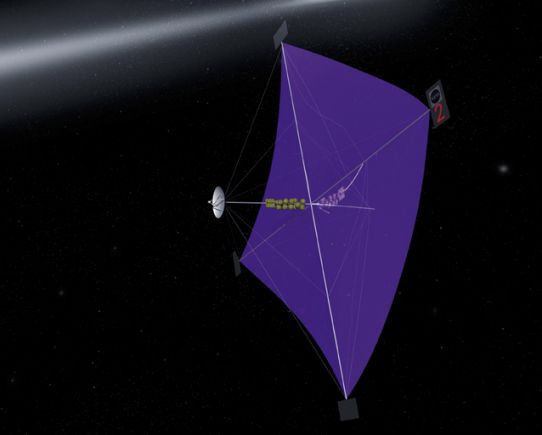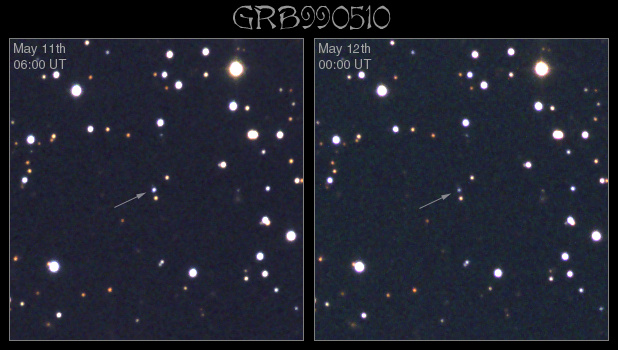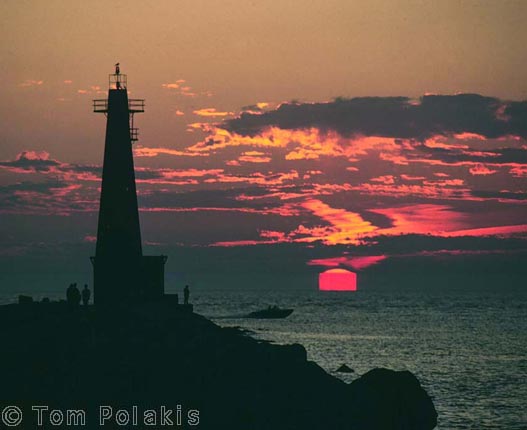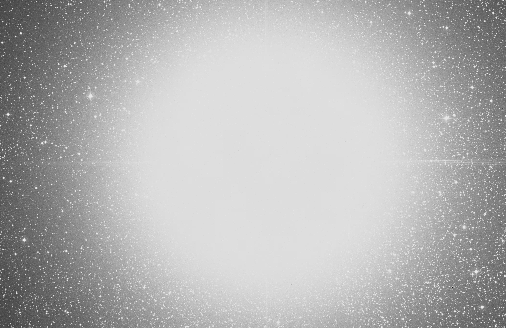| << Previous | Index | Next >> |
2015 What could cause the center of M94 to be so bright? Spiral galaxy M94 has a ring of newly formed stars surrounding its nucleus, giving it not only an unusual appearance but also a strong interior glow. A leading progenitor hypothesis holds that an elongated knot of stars known as a bar rotates in M94 and has generated a burst of star formation in the inner ring. Recent observations have revealed the outer, fainter ring is not closed and relatively complex. M94, pictured here spans about 30,000 light years, lies about 15 million light years away, and can be seen with a small telescope toward the constellation of the Hunting Dogs (Canes Venatici).
2014
Click to play embedded YouTube video.
Video Credit: ESO, José Francisco Salgado, NRAO; Music: Flying Free (Jingle Punks)
2013 As planet Earth approached the plane of the Comet PanSTARRS (C/2011 L4) orbit on May 23rd, comet watchers were treated to this view of its magnificent anti-tail. The long, narrow anti-tail stretches to the right across this frame for nearly 4 degrees or about 8 times the angular size of the full Moon. The tail trails along the comet's orbit as it leaves the inner solar system behind. An almost edge-on perspective from near the outbound comet's orbital plane enhances the view of the anti-tail and makes it seem to point in the sunward direction, only apparently contrary to the behavior of comet dust tails pushed outward by the pressure of sunlight. Sweeping far north in planet Earth's skies, the comet is up all night for most of the northern hemisphere, but now bright moonlight interferes with its visibility. PanSTARRS anti-tail is one of the longest since the appearance of Comet Arend-Roland in 1957.
2012
2011
Title Image: Kepler's Supernova Remnant - Chandra (X-ray) / Hubble (Optical) / Spitzer (IR)
Credit: Alex H. Parker (Univ. Victoria), Melissa L. Graham (Univ. California, Santa Barbara / LCOGT)
Credit: Alex H. Parker (Univ. Victoria), Melissa L. Graham (Univ. California, Santa Barbara / LCOGT)
2010
Click to play embedded YouTube video.
Credit & Copyright: Stéphane Guisard (Los Cielos de America), TWAN
2009 Follow the handle of the Big Dipper away from the dipper's bowl, until you get to the handle's last bright star. Then, just slide your telescope a little south and west and you might find this stunning pair of interacting galaxies, the 51st entry in Charles Messier's famous catalog. Perhaps the original spiral nebula, the large galaxy with well defined spiral structure is also cataloged as NGC 5194. Its spiral arms and dust lanes clearly sweep in front of its companion galaxy (left), NGC 5195. The pair are about 31 million light-years distant and officially lie within the angular boundaries of the small constellation Canes Venatici. Though M51 looks faint and fuzzy to the human eye, the above long-exposure, deep-field image taken last month shows much of the faint complexity that actually surrounds the smaller galaxy.
2008 This flat horizon stretches across the red planet as seen by the Phoenix spacecraft after yesterday's landing on Mars. Touching down shortly after 7:30pm Eastern Time, Phoenix made the first successful soft landing on Mars, using rockets to control its final speed, since the Viking landers in 1976. Launched in August of 2007, Phoenix has now made the northernmost landing and is intended to explore the Martian arctic's potentially ice-rich soil. The lander has returned images and data initially indicating that it is in excellent shape after a nearly flawless descent. News updates will be available throughout the day.
2007 On May 22nd, just days after sharing the western evening sky with Venus, the Moon moved on to Saturn - actually passing in front of the ringed planet when viewed in skies over Europe, northern Africa, and western Asia. Because the Moon and bright planets wander through the sky near the ecliptic plane, such occultation events are not uncommon, but they are dramatic, especially in telescopic views. For example, in this sharp image Saturn is captured emerging from behind the Moon, giving the illusion that it lies just beyond the Moon's bright edge. Of course, the Moon is a mere 400 thousand kilometers away, compared to Saturn's distance of 1.4 billion kilometers. Taken with a digital camera and 20 inch diameter telescope at the Weikersheim Observatory in southern Germany, the picture is a single exposure adjusted to reduce the difference in brightness between Saturn and the cratered lunar surface.
2006 Centaurus, the Centaur, is one of the most striking constellations in the southern sky. The Milky Way flows through this celestial expanse whose wonders also include the closest star to the Sun, Alpha Centauri, and the largest globular star cluster in our galaxy, Omega Centauri. This gorgeous wide-field telescopic view of Omega Centauri shows off the cluster of about 10 million stars and the surrounding star field, with very faint dust clouds and distant background galaxies. Omega Cen itself is about 15,000 light-years away and 150 light-years in diameter - one of 150 or so known globular star clusters that roam the halo of our galaxy. The stars in globular clusters are much older, cooler, and less massive than our Sun.
2005 The beautiful Trifid Nebula (aka M20), a photogenic study in cosmic contrasts, lies about 5,000 light-years away toward the nebula rich constellation Sagittarius. A star forming region in the plane of our galaxy, the Trifid fittingly illustrates three basic types of astronomical nebulae; red emission nebulae dominated by light from hydrogen atoms, blue reflection nebulae produced by dust reflecting starlight, and dark absorption nebulae where dense dust clouds appear in silhouette. The bright red emission nebula, roughly separated into three parts by obscuring dust lanes, lends the Trifid its popular name. In this gorgeous wide view, the red emission region is also surrounded by the telltale blue haze of reflection nebulae. Light-year long pillars and jets sculpted by newborn stars - visible here below the center of the emission nebula - appear in Hubble Space Telescope close-up images of the region.
2004 From martian orbit, the Mars Express cameras looked down on the largest volcano in the solar system. The result was this stunningly detailed overhead view of the caldera or summit crater region of Olympus Mons. Fittingly named for the lofty abode of the gods of Greek mythology, Olympus Mons rises 21 kilometers above the surrounding plain or to about 3 times the height of Mt. Everest. The area pictured is 102 kilometers across and the caldera pits are up to 3 kilometers deep. For comparison, hawaiian volcanic calderas range up to 18 kilometers in diameter. Outlined by steep cliffs, Olympus Mons itself is about 600 kilometers in diameter.
2003 What does Earth look like from Mars? The first image of Earth from the red planet was captured earlier this month by the camera onboard the Mars Global Surveyor spacecraft currently orbiting Mars. Features visible on Earth include the Pacific Ocean, clouds, much of South America, and part of North America. Earth's Moon is visible on the upper right, with the crater Tycho brightening the lower part. Previously, Earth has been imaged from the Moon and spacecraft across the Solar System.
2002 The dark nebula predominant at the lower left of the above photograph is known as the Pipe Nebula. The dark clouds, suggestively shaped like smoke rising from a pipe, are caused by absorption of background starlight by dust. These dust clouds can be traced all the way to the Rho Ophiuchi nebular clouds on the right. The brightest star in the field is Antares. Many types of nebula are highlighted here: the red are emission nebula, the blue are reflection nebula, and the dark are absorption nebula. This picture has been digitally enhanced.
2001 The colorful planetary nebula phase of a sun-like star's life is brief. Almost in the "blink of an eye" - cosmically speaking - the star's outer layers are cast off, forming an expanding emission nebula. This nebula lasts perhaps 10 thousand years compared to a 10 billion year stellar life span. Spectacular planetary nebulae are familiar objects to both professional and amateur astronomers, but they still contain a few surprises. For instance, the lovely nebula NGC 6826, also known as the Blinking Eye Nebula, has mysterious red FLIERS seen on either side of the Hubble Space Telescope image above. Are they also expanding outward from the central star? If so, their "bow shocks" point in the wrong direction!
2000 Nearly 400 years ago astronomer Johannes Kepler observed comet tails blown by a solar breeze and suggested that vessels might likewise navigate through space using appropriately fashioned sails. It is now widely recognized that sunlight does indeed produce a force which moves comet tails and a large, reflective sail could be a practical means of propelling a spacecraft. In fact, the illustration above represents one concept currently being explored by NASA centers to develop an interstellar probe pushed along by sunlight reflected from an ultrathin sail. Nearly half a kilometer wide, the delicate solar sail would be unfurled in space. Continuous pressure from sunlight would ultimately accelerate the craft to speeds about five times higher than possible with conventional rockets -- without requiring any fuel! If launched in 2010 such a probe could overtake Voyager 1, the most distant spacecraft bound for interstellar space, in 2018 going as far in eight years as the Voyager will have journeyed in 41 years.
1999 Another huge explosion has lit up the universe, and astronomers are studying it as best they can before the light fades away. Two weeks ago, the BATSE instrument on the orbiting NASA Great Observatory Compton detected unusually bright flashes of gamma-rays from a point deep in the southern sky. This gamma-ray burst was also recorded by the orbiting Beppo-SAX satellite, which downlinked an accurate position followed by the world's largest optical telescopes. The subsequent fading optical transient, pictured above, is so far out in the universe its light is measured to be redshifted by factor of at least 1.6. The type of powerful explosion that caused this gamma-ray burst is not only still unknown, but found to be fading in an unusual way.
1998 Isn't the Sun round? Yes, but in the above picture, the Earth's atmosphere makes it appear almost square. Here a layer of air near the Earth was so warm it acted like a giant lens, creating increasingly distorted paths for sunlight to reach the camera. Similarly, on a long flat highway, it may appear that the road in the distance is covered with water. In this case, light from the blue sky is being unusually refracted by warm air just above the dry road. No matter how the Earth's atmosphere makes the Sun appear, the Sun will always be spherical. This setting Sun was photographed over Lake Michigan in Muskegon, MI.
1997 As Comet Hale-Bopp leaves our Northern Skies, it provides us with yet another burst of joy. On May 11th the fading comet was photographed behind the famous "Old Faithful" water geyser of Yellowstone National Park, Wyoming, USA, Planet Earth. Perhaps more familiar to Earth Dwellers than the dark geysers on Neptune's moon Triton, the gas geysers on Jupiter's moon Io, and the dirty water geysers hypothesized on Jupiter's moon Europa, Earth's Old Faithful is also reliable - every 60-80 minutes it gushes a plume of water and steam high into the air. Comet Hale-Bopp will continue to be visible to observers in the Southern Hemisphere as it moves away from the Sun towards the outer Solar System.
1996 The closest star system to the Sun is the Alpha Centauri system. Of the three stars in the system, the dimmest -- called Proxima Centauri -- is actually the nearest star. The bright stars Alpha Centauri A and B form a close binary as they are separated by only 23 times the Earth- Sun distance - slightly greater than the distance between Uranus and the Sun. In the above picture, the brightness of the stars overwhelm the photograph causing an illusion of great size, even though the stars are really just small points of light. The Alpha Centauri system is not visible in much of the northern hemisphere. Alpha Centauri A, also known as Rigil Kentaurus, is the brightest star in the constellation of Centaurus and is the fourth brightest star in the night sky. Sirius is the brightest even thought it is more than twice as far away. By an exciting coincidence, Alpha Centauri A is the same type of star as our Sun, causing many to speculate that it might contain planets that harbor life.
| << Previous | Index | Next >> |
